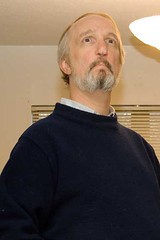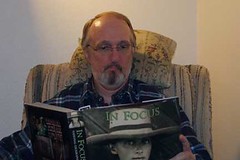
The more talking and thinking, the farther from the truth.
— Seng-Ts’an

Ink stains on the pillow where dreams turned to rust
phantoms on fog streets walk over broken grass
thunderous brows open kitchen sink coffee grounds
counting the rest stops alone your life lines
counting the diversions in your tea leaves
opening blue evening closing your eyes
loving the calendar like a waitress
where dreams turn to rust and collections are untrue
where you open your hand and the rest stops are closed
where you open the central line and the heart beats faster
where the ink stains burn holes into your pillow


One way to become a better photographer is to study the work of the masters. Here, your correspondent is flipping through a Christmas present from a friend, a collection of photographs from the National Geographic. It's possible I'm also concentrating on the radio-controlled shutter release in my right hand.
It is possibly unfair to compare Ms. Armstrong's pamphlet to these others. It is intended as nothing more than a brief introduction, which leads her to make pronouncements with little documentation. She is, in effect, attempting to cover the same material in 176 pages that Joseph Campbell attempted to cover in The Masks of God, which covers four volumes; any one of which is three times longer than Ms. Armstrong's book.
Most of Ms. Armstrong's history corresponds with Campbell's work. However, she does not clearly demark opinion from fact or generally accepted theory, which I see as a flaw. Coupled with the lack of citations, this flaw rates the work as a very slight monograph at best.
I think it likely these flaws result from the book's brevity. The other books in "The Myths" series are about the same length, and could reasonably be called "novellas" rather than novels. My suspicion is that Ms. Armstrong was asked to write an introduction less than 200 pages long, so the book would be about the same size as the other books in the series.
I suppose the book works as a simplistic and very general introduction. It might be useful for a high school student who couldn't read Joseph Campbell.
There is one final flaw, which I find the most disappointing: the last chapter attempts to argue that new myths are being created in books. The problem with this argument is that most of the monograph has approached myth-making as a communal event. Reading is a strikingly individual pursuit. I think a stronger argument can be made that movies are the new mythology (Joseph Campbell actually made this argument) because groups of people typically share movies in a pseudo-cave.